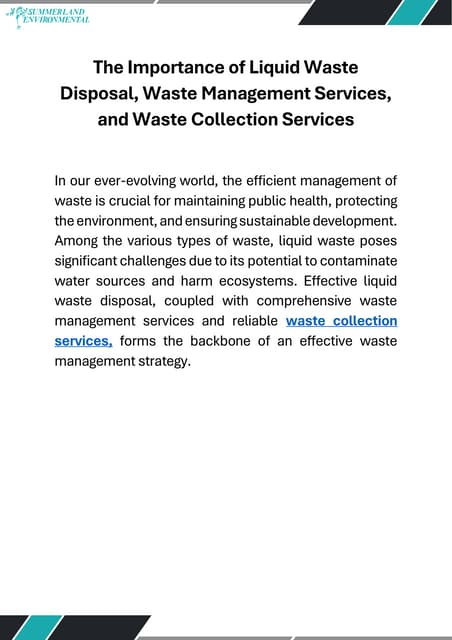The Greatest Guide To Reclaim Waste
Table of ContentsThe Best Guide To Reclaim WasteThe Definitive Guide for Reclaim WasteThe 30-Second Trick For Reclaim WasteThe Facts About Reclaim Waste UncoveredReclaim Waste Things To Know Before You Get This
Domestic sewage waste refers to the waste and items from a property septic tank. The correct administration and disposal of domestic sewage waste call for liquid waste to be moved to a sewage therapy plant where the appropriate techniques and devices are used to detoxify and dispose of waste.
Business waste often consists of potential threats, such as combustible products or a mix of fluid and solid waste products, and needs a more advanced and comprehensive disposal process. The disposal of industrial waste commonly entails the filtration of waste before transport to make certain secure and appropriate disposal. Industrial waste is produced from results and runoff of commercial procedures and production.
This type of waste can not make use of the same sewer monitoring transportation or procedures as septic or industrial fluids. The hazardous waste management process requires the evaluation and testing of liquid waste prior to it undertakes the disposal procedure (liquid waste removal). Overflow waste is the fluid waste that originates from drainage and excess stormwater in highly inhabited areas or cities
Overflow waste can cause contamination and flooding if not taken care of correctly. Making sure appropriate waste management can stop catastrophes and decrease environmental injury.
Reclaim Waste Fundamentals Explained
Contact PROS Providers today to learn more about our waste monitoring and disposal solutions and the correct ways to take care of the fluid waste you create.
(https://reclaimwaste1.wordpress.com/2024/11/12/efficient-liquid-waste-disposal-in-melbourne-reclaim-wastes-expert-solutions/)This so-called 'wastewater' is not just an essential source yet, after therapy, will be launched to our land, rivers or the ocean. Utilized water from toilets, showers, bathrooms, kitchen area sinks, washings and commercial processes is known as wastewater.

water made use of to cool equipment or clean plant and devices). Stormwater, a type of wastewater, is runoff that moves from farming and metropolitan locations such as roof coverings, parks, yards, roadways, paths and gutters right into stormwater drains pipes, after rain. Stormwater moves untreated directly to local creeks or rivers, at some point reaching the sea.
The Basic Principles Of Reclaim Waste
In Queensland, the majority of wastewater is treated at sewage treatment plants. Wastewater is transferred from domestic or industrial sites with a system of sewage systems and pump terminals, known as sewerage reticulation, to a sewage therapy plant. City governments develop, keep and operate most sewer treatment plants. Operators are certified under the Environmental Management Act 1994 to discharge cured wastewater at an acceptable environmental standard right into rivers.
The Department of Natural Resources encourages city governments concerning managing, operating and preserving sewage systems and therapy plants. In unsewered locations, neighborhood governments may require householders to set up individual or family sewer therapy systems to treat residential wastewater from toilets, kitchens, restrooms and laundries. The Division of Natural Resources authorises using house systems when they are confirmed to be reliable.
In some new subdivisions, therapy of some stormwater to remove clutter, sand and gravel has begun making use of gross contaminant traps. Wastewater treatment occurs in four phases: Eliminates strong matter.
Wastewater then streams into huge containers where solids work out and are removed as sludge. Grease and scum are skimmed from the surface. Utilizes small living microorganisms called micro-organisms to break down and remove continuing to be dissolved wastes and great bits. Micro-organisms and wastes are incorporated in the sludge. Removes nitrogen and phosphorus nutrients that could create algal blossoms in our rivers and intimidate marine life.
Unknown Facts About Reclaim Waste
Nutrient elimination is not offered at all sewer treatment plants since it calls for pricey specialised visit this site right here devices. Clear liquid effluent created after therapy might still include disease-causing micro-organisms - liquid waste removal melbourne.

This typically implies wastewater has to be treated or impurities gotten rid of prior to it can be discharged to rivers. The majority of wastewater moves right into the sewerage system. Under the Act, local federal governments carry out authorizations and permits for ecologically relevant tasks (Ages) including wastewater releases that could have a regional impact. The division administers authorizations and licences to Periods including wastewater releases that could have a regional or statewide impact.
Not known Details About Reclaim Waste
Otherwise, examples are taken for lab evaluation. Frequently several tests are needed to develop the degrees of each of the different contaminants such as oils, hefty steels and pesticides in water. Surveillance provides factual info concerning water quality and can verify that permit problems are being met. The details obtained through surveillance offers the basis for making water quality choices.